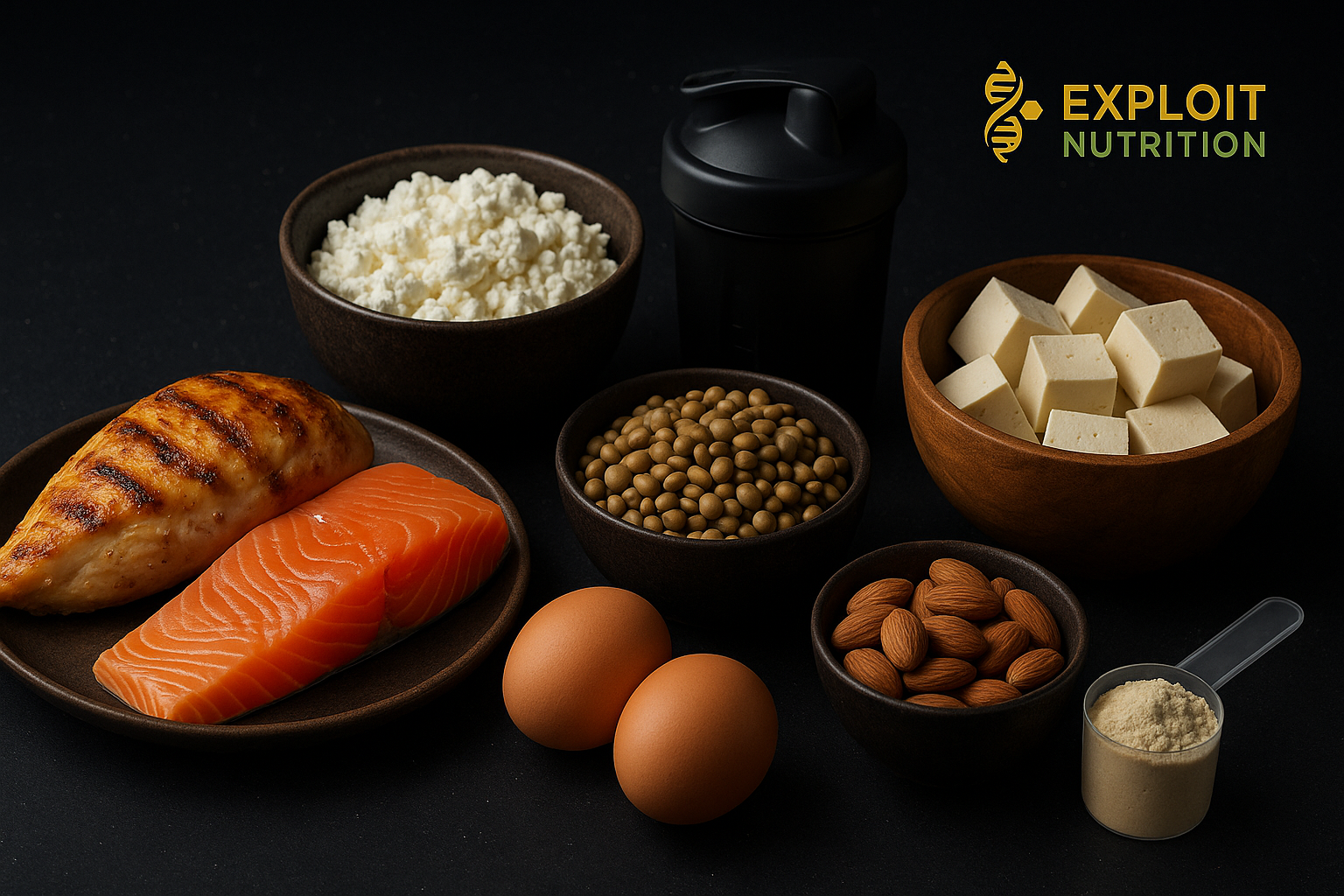Protein
image by Teleportstrength.com
Protein & Amino Acids
Key terms
Protein: Large molecules made of amino-acid chains (polypeptides) folded into specific shapes that do work in cells.
Amino acid (AA): Building blocks of protein; each has an amino group (–NH₂), carboxyl group (–COOH), a hydrogen, and a variable R-group.
Peptide bond: Link between amino acids formed during protein synthesis; many links = polypeptide.
Primary/secondary/tertiary/quaternary structure: Levels of protein structure—from AA sequence to final multi-subunit complex—that determine function.
Essential amino acids (EAA): Must come from diet (body can’t make enough).
Non-essential amino acids (NEAA): Body can synthesize from other substrates.
Conditionally essential AAs: Usually synthesized, but required from diet during stress, illness, growth (e.g., trauma).
Complete protein: Contains adequate amounts of all EAAs (e.g., eggs, dairy, meat, soy, quinoa).
Incomplete protein: Lacks one or more EAAs (many single plant sources); complementary proteins combine to cover all EAAs (e.g., rice + beans).
Leucine & mTOR: Leucine (a BCAA) triggers the mTOR pathway to start muscle protein synthesis (MPS)—think “on switch.”
BCAA: Branched-chain AAs—leucine, isoleucine, valine; important for MPS and fuel in muscle.
Nitrogen balance: Intake – loss of nitrogen; positive = tissue building, negative = breakdown.
PDCAAS / DIAAS: Scores estimating protein quality/bioavailability (DIAAS is newer and more precise).
Functions & physiological effects
Structural: Collagen, keratin, actin/myosin build and repair tissues (muscle, skin, bone, tendon).
Enzymes & transport: Almost all enzymes are proteins; hemoglobin, albumin, lipoproteins transport gases and nutrients.
Hormones & signaling: Many hormones (insulin, glucagon), receptors, and cytokines are proteins.
Immune system: Antibodies (immunoglobulins) and acute-phase proteins.
Fluid & pH balance: Plasma proteins maintain oncotic pressure; AA buffers help regulate acid–base status.
Energy & glucose backup: AAs can be oxidized for ~4 kcal/g; glucogenic AAs support gluconeogenesis during fasting/low-carb states.
Neurochemistry: Precursors to neurotransmitters (e.g., tryptophan → serotonin; tyrosine → dopamine/norepinephrine).
Satiety & metabolism: Highest thermic effect of food (~20–30% of calories), strong satiety signaling, and supports body-comp when cutting.
Muscle protein turnover: Dietary protein + mechanical tension stimulate MPS; adequate total protein and leucine-rich feedings limit muscle protein breakdown.
Essential vs non-essential amino acids
Essential (dietary) — 9
Histidine (His)
Isoleucine (Ile)
Leucine (Leu)
Lysine (Lys)
Methionine (Met)
Phenylalanine (Phe)
Threonine (Thr)
Tryptophan (Trp)
Valine (Val)
Conditionally essential (context-dependent)
Arginine, Cysteine, Glutamine, Glycine, Proline, Tyrosine
(Needs can exceed synthesis during growth, illness, injury, or endurance/strength overload.)
Non-essential (synthesized)
Alanine, Asparagine, Aspartate, Glutamate, Serine
Practical takeaways
Center each meal on a high-quality protein source (complete proteins or complementary plants).
For hypertrophy/strength: aim roughly 1.6–2.2 g/kg/day protein, spaced over 3–5 meals with ~2–3 g leucine (≈ 25–40 g high-quality protein) per meal to trigger MPS.
Combine protein with complex carbs and healthy fats for performance, recovery, and micronutrient coverage.

